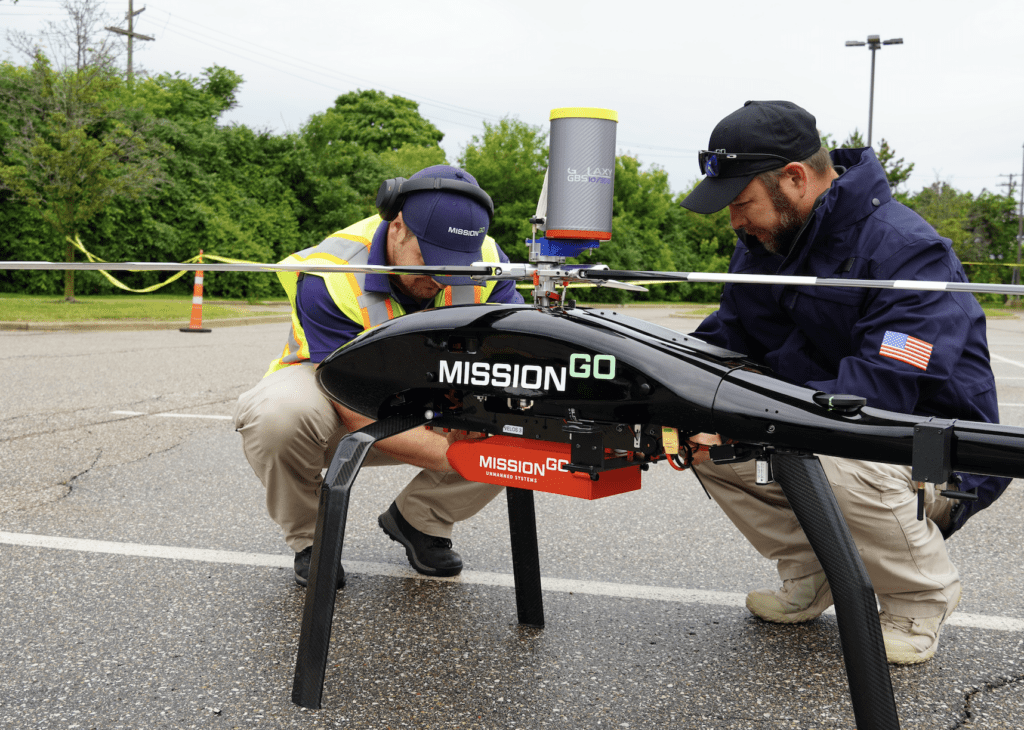
MissionGO’s all-electric, uncrewed MGV100—pictured above—performed 40 flights during a 10-day study, done in partnership with Airspace Link. (Photo: MissionGO)
MissionGO Unmanned Systems recently partnered with Airspace Link for a 10-day flight operation to demonstrate use of an uncrewed aircraft to perform cargo delivery services. The study, which marked the first real-world cargo delivery operations via uncrewed aircraft in the state of Michigan, included collaboration with community leaders of metropolitan Detroit, as well as with Beaumont Health Spectrum Health, Michigan Economic Development Corporation, and NextEnergy. The uncrewed aircraft system (UAS) used by MissionGO and Airspace Link was an all-electric MGV100—a single-rotor helicopter that is going through Type, Production, and Part 135 Certification with the Federal Aviation Administration.
Airspace Link has previously partnered with Thales for a UAS network in North Dakota, and in May 2021 the companies formed a new partnership to integrate ground risk data into an air traffic management (ATM) system for UAS.
The UAS flights proved to be a successful test case for MissionGO, as well as a good challenge for the team, shared the company’s president, Chris Corgnati. Aspects of the environment that provided obstacles to the mission included power lines, railroads, and traffic from a nearby airport. “It was a great way to showcase not only the capabilities of the aircraft but of our crew,” Corgnati told Avionics.
Ryan Henderson, MissionGO’s lead pilot, commented that this particular operation involved delivering cargo between two locations. Many other uncrewed systems are performing operations that take off and land at the same location. In these recent flights by MissionGO and Airspace Link, the MGV100 took off at point A, flew about 1 mile, landed at point B, then returned to point A. The team performed 40 flights during the 10-day period of the study, Henderson said.

MissionGO is pursuing Type, Production, and Part 135 Certification with the FAA for its uncrewed aircraft, a single-rotor helicopter, pictured above. (Photo: MissionGO)
The current regulatory environment for UAS operations requires a visual observer during an aircraft’s entire flight. For the mile-long flight path in MissionGO’s study, it was necessary to station crews in numerous areas to establish and maintain a visual line of sight on the aircraft. “We were able to show how robust our operations were by doing it again and again over the 10-day period,” Henderson commented. The MGV100 carried air radios and ADS-B onboard, which helped to establish full visual and auditory awareness of the existing air traffic.
The data and results of the study will be published in about three weeks. The purpose of this mission, according to Henderson, is to demonstrate that uncrewed systems can perform operations as efficiently—or perhaps more efficiently—than ground-based transportation. The study examined environmental factors like carbon footprint in addition to the speed of small UAS operations.
Henderson is confident that public acceptance of small UAS operations in the future will not be an issue. Although many bystanders noticed MissionGO’s aircraft in operation during the study, no one was concerned about it. Their vehicle also has a low noise profile. “If there was any amount of ambient noise in the area, when our helicopter is at altitude—just under 400 feet—you can’t hear it,” he said. “Every single aircraft taking off or landing at the local airport was magnitudes louder than our electric helicopter.”
This study “proves just how sustainable using small unmanned systems in an urban environment really is,” he added.
MissionGO plans to continue to expand work in its three main verticals: infrastructure inspection, critical cargo delivery, and training. President Chris Corgnati shared that a major application for their UAS is inspecting utilities for fire prevention—in particular on the West Coast, where the company is expanding. MissionGO and Airspace Link are also considering partnering again for similar projects. “We set up this operation for two weeks,” he said, “but we can build this operation and do this every day of the year if need be.”
The company is one of an initial 14 small UAS companies with an aircraft that is in line to be type certified with the FAA. Once the agency finalizes the criteria for certification, says Corgnati, that will open up opportunities in the industry for routine beyond visual line of sight (BVLOS) operations as well as flight over people.
MissionGO conducted a similar series of flight demonstrations in January. The team performed four cargo deliveries, including medical and emergency supplies, in Window Rock, Arizona. The objective of these demonstrations was to showcase MissionGO’s ability to transport essential items to remote areas of the Navajo Nation.